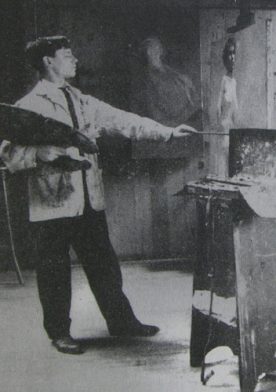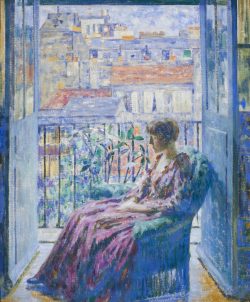Louis Ritman painting in his studio, from an undated photograph, courtesy Redfern Gallery.

Louis Ritman 1889–1963
Louis Ritman immigrated to the United States as a child with his family from their native Kamenets-Podolsky, Russia (now Ukraine), to settle in Chicago. Working as a sign painter to support his impoverished family, the young Ritman began his art training with a drawing class at Hull-House; he then attended the Art Institute of Chicago, the Chicago Academy of Fine Arts (founded in 1902), and briefly the Pennsylvania Academy of the Fine Arts in Philadelphia. Ritman began participating in the Art Institute’s annual exhibitions in 1907 and soon was receiving commissions for portraits. Encouraged by Lawton Parker, he went to Paris in 1909 for further training at the École des Beaux-Arts. Two of his paintings were juried into the prestigious Salon exhibition of 1911.
In 1910, along with expatriate artist Richard Miller, Ritman made his first visit to the colony of impressionist painters in the Normandy village of Giverny. Except for a brief hiatus just after the outbreak of World War I, he would paint there almost every summer through 1928, while maintaining a winter studio in Paris and returning frequently to the United States. Working closely with Miller, Parker, and Frederick Frieseke, another important member of the third generation of American impressionists in Giverny, Ritman painted the group’s signature subjects: lovely young women posed clothed or nude in the sun-dappled outdoors or in brightly lit domestic interiors. A display of Ritman’s painting held in Parker’s Chicago studio in late 1914 and a solo show at the Art Institute early the following year were well-received. Around this time Ritman, influenced by the work of French master Paul Cézanne, began to emphasize underlying structure in his compositions and to apply paint in broad patches. In the following decade, he abandoned the fresh hues and bright light of impressionism for a darker range of colors.
Ritman exhibited his works in a number of prominent national and international venues and won several important prizes. He moved back to Chicago in 1929 but continued to visit France. In 1930 he began a long career as a teacher of figure and portrait painting at the Art Institute. Ritman expanded his subject matter to include landscapes, many painted in Michigan, and still lifes, in addition to his signature figural images; he also took up watercolor painting. Well into 1950s he was abundantly represented in the annual exhibitions at the Art Institute, the Pennsylvania Academy of the Fine Arts, and the National Academy of Design, to which he was elected a full member in 1950. Chronic illness forced Ritman to retire from both teaching and painting around 1958, some five years before his death at age seventy-four.
Wendy Greenhouse, PhD
